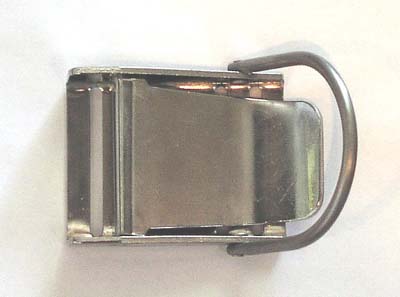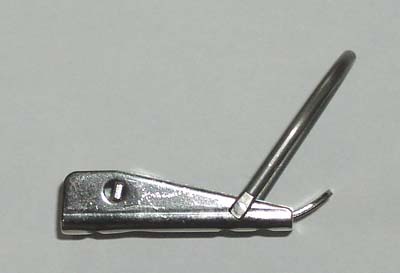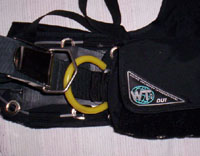 |
 |
| BRYDEN BUCKLE (TOP) | BRYDEN BUCKLE (PROFILE) |
| The Bryden buckle has a low-profile, pivoting "D-ring" that allows the buckle to be quick-released. I use one as the primary buckle on each of my backplates. At the start of a dive I might clip a beacon to that buckle so it is immediately accessible. At the end of the dive I'll clip the beacon off to the Robson buckle, described below. |
 |
 |
| ROBSON BUCKLE (TOP) | ROBSON BUCKLE (PROFILE) |
| The Robson buckle has a high-profile, fixed "D-ring". I use one on the right waist strap of each of my backplates with either a canister light or my "Light Saver". It's ideal for clipping a reel or other piece of gear. If you carry a deco bottle on the right side it's ideal for that as well. The buckle's position can be adjusted even with gear clipped to the d-ring. At the end of a dive that I deployed a beacon from the Bryden buckle I'll clip the beacon to the Robson buckle. If you don't own a canister light, it is still useful as an easily adjusted, secure, not-permanent D-ring. |
BUOYANCY COMPENSATION
| When I was first certified I used a "mae-west" lifevest as a BC. It lacked a power inflator but it had a snazzy CO2 cartridge!!! From there I graduated to a SeaTec horse-collar style BC with power inflator. Later I began using a jacket style BC and a few years ago switched to a BP.I currently own three backplates, 2 STAs (single tank adapters) and a selection of wings that are matched to the dive. One BP is an older, modified (that is, I drilled holes where I needed), stainless steel OMS plate with one piece single tank adapter (STA). To prevent breakage (because I broke some plastic buckles) the STA has been fitted with Halcyon stainless steel cam-buckles. The second plate is a special order Fred Tagge Aluminum plate with FredT two piece lightweight STA. Each half of the STA is fitted with SCUBAPro cinch-straps. The third plate is a small FredT AL BP that was intended for my wife but she has not decided to use it. Therefore I rigged a simple harness and find that it's ideal for single tank dives with a wetsuit during the summer. It does look a bit odd though because the fixed position d-rings are a mish-mash of what I had on hand.All of the BP harnesses are one continuous piece of webbing with shoulder and left waist mounted d-rings. The crotch strap is bolted in place underneath the plate, not through the plate and it has one d-ring in the rear. Because I use a large knife and carry that knife center of my body, the crotch strap connection to the waist strap has been configured for my convenience. I do not use a scooter so there is no scooter d-ring in front on the crotch strap.I use large fixed-position (aka "Billy") rings that were custom ordered from Fred T. He now stocks them as a 'special order' item. They are one-piece 45 degree fixed rings on the shoulder and 90 degree fixed rings on the waist. They are extra large to accomodate the extra-large bolt snaps I use and I find fixed rings to be more easily accessed. Fred makes a variety of backplates and other hardware using aluminum and stainless steel. You can send an email to him if you are interested in a list of his products. The various wings I use are matched to the tank(s) I am about to carry or the environment I am diving. I have a DeepSeaSupply LCD30 , a mid-sized AUL wing, a Halcyon Explorer 55, and an OxyCheq 70. None of the wings has a "pull dump" and the connection to the body of the wing is a simple 'elbow'. The knobs on the lower left OP valve have been removed and the end of the line melted and knotted so I can feel the line even while wearing my cold water gear. Additionally, there are 2 pieces of bicycle-tire inner tube on the corrugated inflate hose. The LP hose from my regulator first stage slides under those inner tube segments and stays nicely streamlined. |
 |
 |
| OMS PLATE | OMS STA |
 |
 |
| FREDT PLATE | FREDT STA |
 |
 |
| FREDT 90 DEG DEEP RING | FREDT 45 DEG DEEP RING |
 |
 |
| CROTCH STRAP BOLT | CROTCH STRAP CONNECTION |
BALLAST
| I currently use a DUI W&T II System for ballast. I find conventional weight belts to be uncomfortable and I need to place the weight low on my body, so the DUI system works well for me. But it's not ideal; the pockets were prone to "sliding" and I did not like the dangly shoulder and waist straps. Therefore I modified the system. Pictures with descriptions are below. The modifications in the first three pictures were presented to a DUI rep at DEMA 2005 and he said they had merit. The fourth picture shows that I eventually replaced the fastex (breakable) buckle with a Bryden buckle. We exchanged business cards and when I returned home I sent an e-mail to DUI, along with pictures. Who knows if DUI will incorporate the mods but even if they do ... you saw it here first from the Green Manelishi !!! |
 |
 |
 |
 |
EXPOSURE PROTECTION
| Depending on the time of year and/or dive I am planning, I use either a dry suit or wetsuit. During the summer I frequently wear a wetsuit; using a BP and small steel HP tank I do not need a weight belt. Fall, winter, spring or deep dive in the summer I use a drysuit; then I need a weightbelt. My drysuits are a Viking Extreme and a White's. Underneath I wear a heavy Abyss fleece with a 'dive skin' as a liner. During the winter I'll add a fleece vest. I have a DUI thinsulate that was given to me but either I am/was too large or it's too small so I have opted to not use it. Besides, the fleece keeps me warm enough for long enough. The Viking drysuit has homemade pockets as well as a homemade zipper protector. The White's suit, bought used, came with nice pockets as well as a zipper protector. My wetsuit is an ONeill 7MM one-piece which is worn with a worn with a hooded vest and a 'dive-skin'. The ONeill has no pockets but I occasionally use a DiveRite thigh pocket with that suit. Whether I am diving in a pool or open water, summer or winter, wetsuit or drysuit I wear a hood and heavy mitts or dry-gloves. I firmly believe in remaining accustomed to the exposure protection that must be worn during the coldest months, so that's why I cover my head and hands even in the pool. |
 |
 |
 |
| OPEN ZIPPER PROTECT | CLOSED ZIPPER PROTECT | HOME MADE POCKET |
MASK, FINS, SNORKEL
TANKS, VALVES, REGULATORS
| I own a few single tanks (an LP104, an LP120 and 2 HP80s) and a couple of sets of double LP95s. The doubles are fitted with isolation manifolds, the singles with H valves. I do not use H-valves for any perceived redundancy; I use them to remain accustomed to using two regulators as well as not having to reconfigure gear when I switch between doubles and singles.For deco bottles I use Al40s. For Argon bottles I use AL 6s or an aluminum LP12. The 6s, which I prefer, are attached to my backplate in a manner that I can ditch it if necessary. The AL12 is used by attaching it (ditchable) to my doubles but it's a bit large for my comfort and I do not need such a large amount of Argon. I use an AL6 anytime I dive the drysuit so I remain accustomed to its presence and I do not have to reconfigure gear (1st stage) based on using or not using a separate suit inflation/insulation gas. Because I use the AL6 all the time with the drysuit, when I dive a wetsuit I do not have an unused LP hose hanging from my backup 1st stage.My primary and backup regulators are SCUBAPro MK16s (diaphragm) mated to Atomic B1 second stages. I suffered from Bell's Palsy in the late 1980s so smaller and lighter second stages are easier to keep securely in my mouth. My primary regulator has a long hose and is mounted, as I wear the tank(s), on the right post. The primary first stage also provides gas to my wing. The backup regulator with SPG is mounted on the left post and that second stage is on a shock-cord "necklace".My two deco regulators are Atomic B1 first stages with a Sherwood "Blizzard" second stage on one and an Aqualung Arctic on the other. Each has a metal-case SPG on a 6inch hose. My deco reg storage bands are slices of an appropriately sized inner-tube placed on the bottle. I placed a little loop of duct-tape on each upper band so I can more easily secure my deco regs.My primary Argon regulator first stages are Prosub something-or-others with a "button" style SPG and OP relief. If those fail I have 1 or 2 extra Atomic Z1 1st stages that I could use. Someday, perhaps, I will replace the Sherwood and Artic second stages but currently I use what I had available; it works and it is reliable. |
HOSES
| Some time ago, having grown tired of fighting with the LP hose to drysuit or wing connection, I wrapped a zip tie around the connection and trimmed the loose end. It was functional but could only be used if the LP fitting had a smooth section in between two knurled sections. Tobin George at Deep Sea Supply came up with a better idea. Pictures below depicting both schemes. Of course, if you are using a Viking (and DUI?) hose/fitting you probably don't have this "problem". |
 |
 |
| GM/RMS ZIP TIE | DSS HOSE HAT |
GAUGES
| My gauges are a UWatec digital BT/DG and an Abyss analog DG with an attached Casio "Mariner" watch that is resistant to 600 feet. I chose the Casio because its controls can be activated while wearing heavy exposure protection. The compass is a simple Ikelite. I own a DaCor digital that gave up the ghost sometime ago but I am ever hopeful that it will miraculously begin working. Of course, if it did start working again I would not trust it for anything more demanding that keeping track of bottom time on shallow shore dives at Nubble Light in York, ME. All gauge straps have been replaced by lengths of shock-cord so I can simply slide the gauges on and off over my hands. The shock-cord has a bit of extra on the end so that I can snug (or loosen) them a bit as I switch between wetsuit and drysuit. |
 |
| GAUGES |
KNIVES AND CUTTING TOOLS
| A fair bit of my diving is to recover lobster traps for a friend and those traps are typically fouled on each other and who knows what else, on the bottom. My gallery has a few pictures of a "lobby trap recovery". I'd say I use a knife more times in a year than many will in a lifetime, and I am cutting rope, not string. Over the years my cutting tools have been changed but at this time my primary dive knives, I own two, are modified Buck Intrepids. The steel is high-carbon stainless so it will rust if not cared for, but I clean it after each dive. It came with some removable scales that I removed and tossed into a box ... the scales trap water and because I wear thick gloves/mitts I do not need them to "fill my hand". The BI also had a sharp edge, on the spine, that I did not need so I stoned it and it's now as dull as a spoon. I also rounded off the point. The knife is carried on my BP waistband. I also carry a secondary cutting tool, which is a set of OMS shears. For several years my secondary tool was a SpyderCo "Police" model or Abyss line cutter. The "Police" model was replaced, late 2005, by a SpyderCo "Atlantic Salt" model folder but the "Salt" is now a carry knife for when I am near water; it is rust proof. The Abyss "line cutter" is no longer carried. You'll note the knife and shears have a lanyard; that's to prevent me dropping and losing the tool when I am recovering lobster traps that are "off the bottom". I've recovered several from mooring/channel marker chains and the bottom was not in sight. |
 |
 |
 |
| CUTTING TOOLS | KNIFE & SHEATH | KNIFE & SHEATH W/ LANYARD |
SPOOLS AND REELS
Because I found conventional spools to be somewhat lacking in ease of handling with heavy gloves, and line capacity when using thick line,
I made a few (and have since broken one) long spools. They will hold 200-250 feet of #48 line and I can securely hold one end
of the spool while I wind the line back onto the spool . Sometime after I made the delrin long-spools, Tobin George @
Deep Sea Supply provided me with a custom stainless steel version
Both of my reels, an OMS and a ReefSCUBA, have been modified to help prevent jamming. So far the modifications work very well. I was told that a major weakness with the OMS reel that I owned is the welded-on spindle; so I cut off the spindle,
drilled through the frame and passed a bolt through the spool and frame then locked it down via Loctite and elbow-grease. It's held since late 2003, early 2004.
Lastly (on this subject), I have found that a delrin "plug" or nylon washer on the line helps me work with it when I
am wearing heavy mitts/gloves.
LIFT BAGS
LIGHT SAVER
OTHER
|

















